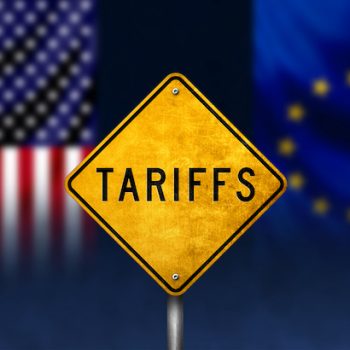Insights: turning global disruption into opportunity
By Melita KielyIn a volatile economic environment, how can spirits brands ensure they are equipped to not only survive, but thrive?

“There are a couple of secret weapons that small brands have; one is agility, and one is often passion, driven by the founder or the creator of the brand,” said Nick Gillett, managing director of distributor Mangrove Global.
“This is why you should be embracing the current economic situation; because what happens when you have, maybe, a president in the US who decides on a tariff policy that throws the whole world into shock? It creates chaos. It breaks boundaries. It’s causing people to question relationships. If you’re fast and agile, and [have] the right product, you can use that to your advantage.
“The one thing you need to happen, is you need to be given an opportunity.”
Gillett was speaking during a seminar at this year’s Bar Convent Berlin (BCB) trade show, titled ‘Navigating Economic Uncertainty: Turning Global Disruption into Opportunity’. He was joined by fellow speakers Christine LoCascio, chief of policy, strategy and membership at the Distilled Spirits Council of the US (Discus), and Mehul Brahmbhatt, founder of Tharra Company.
Gillett noted multiple headwinds that have impacted the industry in the last few years, including mounting costs, inflation “through the roof”, tax increases, and competition to reduce shelf prices.
So, how can brands mitigate the effects of these challenges? After all, shelf prices cannot come down while costs throughout the supply chain are on the up.
However, Gillett noted: “When the costs are moving, they tend to move for everybody, big and small, so you can do things to mitigate [them]. You can choose to absorb those prices if you so wanted to, but you can change things like packaging.
“If you are one of the biggest drinks companies in the world, your whole supply chain is set up to be ultra-efficient, and you have ‘X’ number of million bottles at any one moment in transit. So, although you can adapt and change [your packaging], it takes quite a long time. It’s quite expensive.
“If you’re smaller, you can adapt quicker.
“What is clear around the world, is volatility, economic changes, the availability of market capital, the tax rate, they’re not going away, and there’ll be a new one every few months. The mistake is waiting too long. The mistake I made when Brexit happened is I didn’t raise my prices despite the pound going on the floor. I was too slow to react and I was too frightened to raise my prices, and I thought better times will come. I’ll let you know when they’ve come back…”
He noted the introduction of the Extended Producer Responsibility (EPR) scheme in the UK, which “taxes you to aid recycling for materials”. The tax on glass for 2025-2026 will be £192 (US$255) a tonne. “I bring in something like 4,500 tonnes of glass that’s eligible, so it’s a big cost for me,” he said. “What do I do with that cost? Well, I pass it onto my customers because I have no choice, right? I can’t absorb that. So the only way I can mitigate that is to change packaging.”

Aluminium is an alternative that has already been adopted by some, including English gin brand Penrhos. The material is infinitely recyclable, like glass, but far more lightweight, even though it would still fall under the EPR tax.
Gillett also noted the tariff disputes of bygone years, which resurfaced this year as Donald Trump was re-elected US president. The previous retaliatory 25% tariff from the EU on American whiskey during his first presidency created opportunity for other whisky producers outside of the States.
Gillett recalled: “All those people in the UK who’d been drinking American whiskey suddenly found their product considerably more expensive. The smart guys with products that were similar in profile, they didn’t have that tariff. So this global economic uncertainty, this challenge that American producers were facing, the ‘band of brothers’ that is drinks, they went in and probably, I would argue, American whiskey hasn’t recovered from that original tariff because people take opportunity.”
He pointed to Canada as a current example, where American products have been boycotted and removed from store shelves in retaliation of Trump’s tariff threats. The impact has been huge, with US spirits exports to Canada down by 85% during the second quarter of 2025.
“Again, smart producers, people who can react quite quickly, people who can sit in their office and generate on AI in an afternoon, can whack out a little bit of advertising that builds on that emotion.”
Gillett added: “Those brands who can adapt packaging, pricing without substituting quality, are the ones that are winning opportunities around. So I guess my message, before I hand over, is when you’re not the biggest and you’re not a dominant in a market position, embrace the shots and the change – and yes, it’s hard, I don’t pretend it isn’t hard – because that’s going to provide you the opportunity to get your brand out there.”
‘Those who are agile, usually thrive’
As LoCascio took to the podium, she began by echoing much of Gillett’s sentiment: “I fully agree, those who are agile and adapt are the ones that usually thrive.”
Delving deeper into the US marketplace, she expanded on the tariff uncertainty and highlighted additional challenges in the country, such as court cases.
“How do we move from all of this uncertainty to being more certain about what is going on in the US marketplace? I’m not going to sugar-coat things. It is a challenging marketplace,” LoCascio said.
She described the 2024 spirits market in the US as “still pretty strong. From a supplier revenue perspective, we dominate the market.”
For the last few years, spirits sales have been more than beer or wine, and the category has 42.2% of the total beverage alcohol marketplace in terms of supplier revenue now, LoCascio said.
The value of the US marketplace in 2024 was slightly more than US$37 million, she said.
In the first half of 2025, spirits continued to outperform wine and beer by both volume and value, according to NielsenIQ data shared by Discus. While volume dropped by 1.1% year on year during the first half of 2025, value sales were up by 1.3%.
Exports of American spirits dropped during the second quarter of 2025, however, according to the Discus mid-year export report.
She pointed to some key trends from the past decade: “Interestingly, we see American whiskey has climbed about 93%; cocktails and ready-to-drink products have had astonishing growth of over 900%, and obviously that’s coming from a very small base, but that is a significant driver of growth in the spirits market. Tequila and mezcal have grown by over 200% and vodka at 25%.
“Supplier revenues from the fastest-growing categories have nearly tripled over that period, reaching US$16.3 billion, and Irish whiskey has been growing quite significantly.”
‘Every challenge does present an opportunity’

While acknowledging the challenging environment this year, LoCascio showed there were “some silver linings and pockets of positivity”.
LoCascio highlighted data collected from the control states, representing a quarter of the market. The data showed retail sales had dropped by around 3%, but this did not include spirits-based RTDs.
“Now, certainly, it will not come as a surprise that imports have been declining in the first half of the year,” she added, noting exports to the EU were down about 12% in the second half of the year, according to the Discus mid-year report, and by about 9% overall, “though it’s a little bit too early to speculate exactly why they are down”.
However, she added: “Every challenge does present an opportunity, and certainly this new trade paradigm that we are facing with the administration is leading to opportunities for us. Earlier in the year, the Indian government decided that they would lower their tariff on American whiskey from the 150% rate that they apply to 100% – so its’ still astronomical, but it was an amazing reduction. So we are looking forward to continued negotiations and continued opportunities to open up markets for US spirits exports around the world.
“Recently, Türkiye, who had been imposing retaliatory tariffs on many US goods for about seven years now, decided to lift [its 70% retaliatory] tariffs. So there are some opportunities and certainly as a trade association we are trying to work with the administration to help promote and secure open markets for US spirits exports around the world.”
Another point of opportunity LoCascio highlighted was tourism, which many distillers are focusing on to build their brands and consumer relationships. “US distillery tourism is a really important economic driver,” she said.
Education is another key opportunity, she added. “How can [US distilleries] positively impact their bottom line? One way is through energy efficiency,” LoCascio said. “We have been working with the EPA [US Environmental Protection Agency] for many years to help develop ways that distilleries can reduce their overall energy costs. And this certainly important from a business perspective.” Free resources regarding this, plus distillery tourism, are available on the Discus website.
“We are working every day to defend the industry’s priorities, whether it’s on tariffs, whether it’s on alcohol and science, whether it’s at a state level, [or] fighting back on proposed tax increases. Our work really is to help modernise policy and protect economic growth.”
Related news
Finding growth and profitability in a challenging economy
